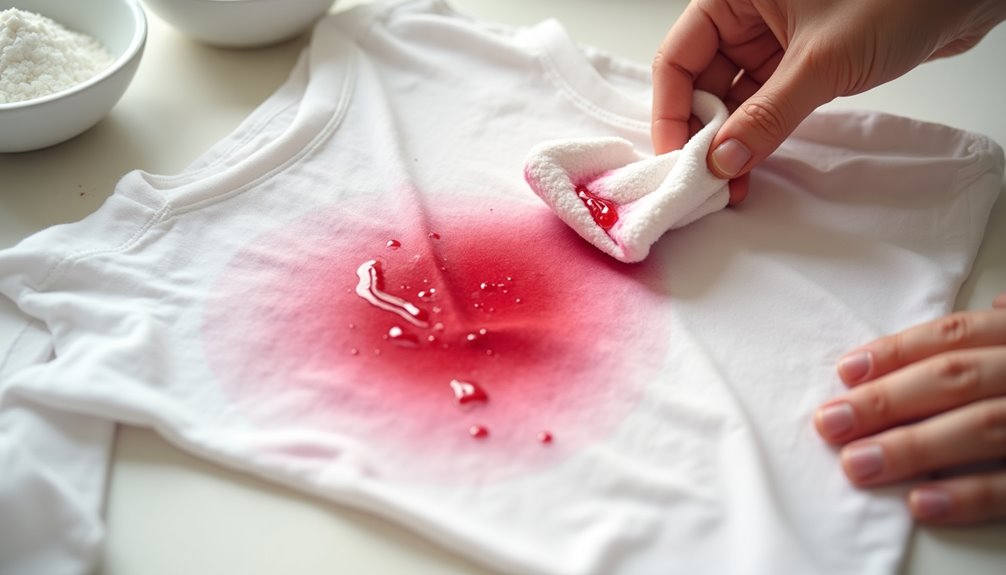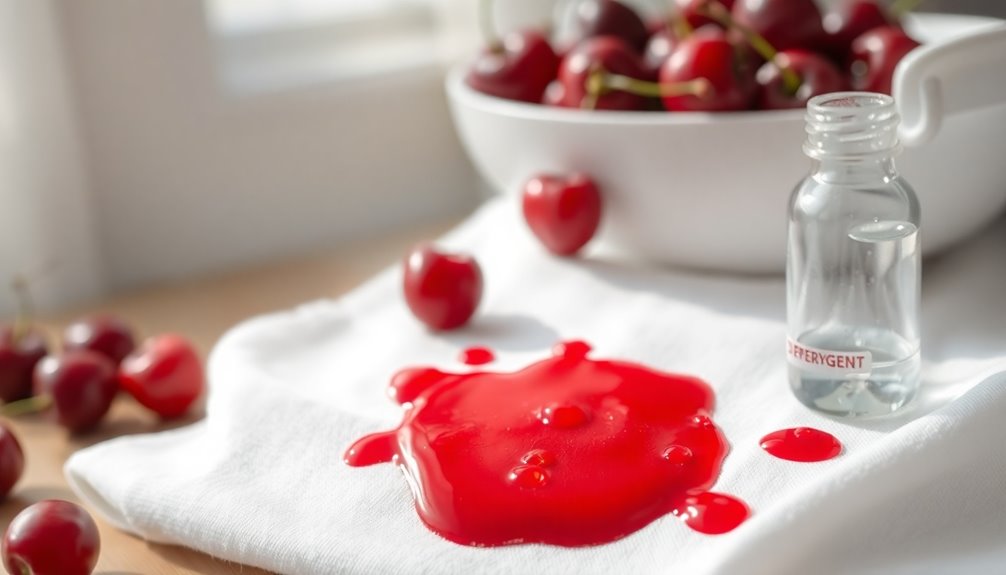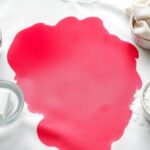To get cherry juice out of clothing, act fast! Start by sponging the stain with cool water and blot gently. Apply lemon juice or vinegar for five minutes to lift the stain. Then, use a heavy-duty laundry detergent, rubbing it in and letting it sit for 15 minutes. Wash in the hottest water safe for the fabric, and don't put it in the dryer if the stain remains. There's more to mastering stain removal techniques!
Key Takeaways
- Act quickly by sponging the cherry juice stain with cool water, blotting gently to avoid spreading.
- Apply lemon juice or vinegar directly onto the stain and let it sit for five minutes.
- Use a heavy-duty liquid laundry detergent, applying it generously and rubbing it in gently.
- Wash the garment in the hottest water recommended for the fabric, ensuring proper detergent use.
- If the stain persists, avoid the dryer, repeat the treatment, and wash again for better results.

If you've ever spilled cherry juice on your favorite shirt, you know how frustrating it can be. Those vibrant red stains can seem almost impossible to remove, but don't worry; you can tackle them effectively with a few simple steps. The key is to act quickly and use the right techniques to remove cherry stains before they set into the fabric.
First things first, grab a clean cloth and sponge the stain immediately with cool water. This will help dilute the cherry juice and prevent it from soaking deeper into the fabric. Make sure to blot gently, avoiding any rubbing that could spread the stain further.
After you've blotted the initial spill, it's time to take a more proactive approach to eliminate the stain.
Next, apply lemon juice or vinegar directly onto the cherry stain. Both of these natural ingredients work wonders for stain removal, thanks to their acidic properties. Let the solution sit on the stain for about five minutes. This gives it enough time to penetrate and break down the juice's pigments.
After that, rinse the area thoroughly with cool water to wash away any remaining residue.
Now, you'll want to reach for a heavy-duty liquid laundry detergent. Apply it generously to the stained area, rubbing it in gently. Heavy-duty detergents, like Tide or Persil, are specifically designed to tackle tough stains, including those stubborn cherry juice marks.
Allow the detergent to sit for at least 15 minutes before moving on to the washing phase. This extra time helps the detergent bind to the stain and improves your chances of complete removal.
When it's time to wash the item, use the hottest water recommended for that fabric type. Check the care label to avoid any damage during washing. Fill your washing machine and add the heavy-duty detergent, ensuring you use a sufficient amount for optimal stain removal.
If the stain persists after washing, don't throw the garment in the dryer just yet. The heat can set the stain, making it even harder to remove. Instead, repeat the lemon juice or vinegar treatment before washing the item again.
Remember, it's essential to keep an eye on the stain throughout this process. If at any point the stain doesn't seem to be budging, don't hesitate to apply more lemon juice or vinegar.
The combination of these acids with the heavy-duty detergent will help break down the stain even further. If you remain diligent and persistent, you'll have a much better chance of saving that favorite shirt from the clutches of cherry juice disaster.
Frequently Asked Questions
Does Cherry Juice Wash Out of Clothes?
Yes, cherry juice can wash out of clothes if you act quickly.
Rinse the stain with cold water immediately and apply a stain remover. You'll want to treat it promptly to break down the pigments effectively.
If the stain's set, multiple treatments might be necessary, like soaking in a detergent-vinegar solution.
Finally, wash the garment in the hottest water safe for the fabric to ensure the stain's completely gone.
How to Get Red Juice Stains Out of Clothes?
When red juice stains strike like a thief in the night, you need to act fast.
Start by rinsing the stain with cold water from the back of the fabric to help flush it out.
Then, apply lemon juice or vinegar, letting it sit for about five minutes.
Rub in a heavy-duty laundry detergent, let it sit for 15 minutes, and wash in hot water.
If the stain lingers, repeat the process.
Does Oxiclean Remove Cherry Stains?
Yes, OxiClean can effectively remove cherry stains from clothing. Its enzyme-based formula targets tough food stains, making it a solid choice for this type of mess.
To get the best results, you should pre-soak the stained item in a mix of OxiClean and water for at least 30 minutes before washing.
Just remember to check the care label to ensure the fabric can handle the treatment. Act quickly for the best outcome!
How to Get Cherry Soda Out of Clothes?
When cherry soda spills, it's like a mischievous sprite marking its territory. You've got to act swiftly!
First, blot the stain gently to absorb the soda's essence. Rinse it under cold water, pushing the soda out.
Then, mix dish soap with lukewarm water and dab it on the stain. If it lingers like a stubborn shadow, soak the fabric in vinegar-water for 30 minutes.
Always check for remnants before drying!
Conclusion
In conclusion, don't let cherry juice stains ruin your favorite clothes. Act quickly, treat the stain, and rinse thoroughly. Remember, the sooner you tackle it, the better your chances of success. Use cold water, apply stain remover, and launder as usual. With a little patience and the right techniques, you can restore your garments to their former glory. So, grab those supplies, follow the steps, and reclaim your wardrobe from those pesky cherry juice stains!
Cindy thoroughly researches juicing trends, techniques, and recipes to provide readers with practical advice and inspiration. Her writing style is accessible, engaging, and designed to make complex concepts easy to understand. Cindy’s dedication to promoting the advantages of juicing shines through her work, empowering readers to make positive changes in their lives through the simple act of juicing.

















